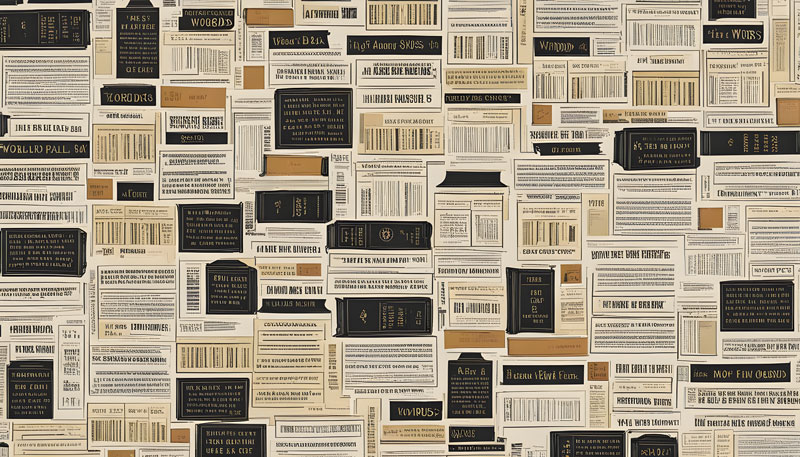The “Bag of Words” (BoW) is a common and simple technique used in natural language processing (NLP) and text analysis. It is used to represent text data as a numerical feature vector, which can be fed into machine learning algorithms for various NLP tasks like text classification, sentiment analysis, and information retrieval. The fundamental idea behind the Bag of Words model is to convert text documents into numerical data by treating each document as an unordered collection, or “bag,” of words.
Pretrained Word Embeddings Explanation & Code
Get Contextual Embeddings from BERT
Python & AI Tools to Read PDF and Summarize
you may be interested in the above articles in irabrod.
Here’s how the Bag of Words model typically works:
1. Tokenization: First, the text is divided into individual words or tokens. This process involves splitting the text into words, removing punctuation, and converting all words to lowercase to ensure consistency.
2. Vocabulary Building: Next, a vocabulary is constructed, which is essentially a list of all unique words that appear in the entire corpus (collection of documents). Each word in the vocabulary is assigned a unique index or ID.
3. Vectorization: For each document in the corpus, a numerical vector is created. This vector has the same length as the vocabulary, and each element in the vector represents the frequency or presence of a word from the vocabulary in the document. There are two common ways to create these vectors:
-Count Vectorization: Each element in the vector represents the count of how many times a word from the vocabulary appears in the document. It’s also known as “Term Frequency” (TF).
– Binary Vectorization: Each element in the vector is binary, indicating whether a word from the vocabulary is present (1) or absent (0) in the document.
4. Sparse Representation: Since most documents contain only a small subset of the words from the vocabulary, the resulting vectors are typically very sparse (mostly filled with zeros).
5. Analysis: The resulting numerical representations can be used for various NLP tasks, such as text classification. Machine learning algorithms can be trained on these feature vectors to make predictions or perform tasks like sentiment analysis or document clustering.
While the Bag of Words model is simple and efficient, it has limitations. It doesn’t consider word order, grammar, or semantic meaning, which can be crucial for understanding text context. More advanced techniques like Word Embeddings (e.g., Word2Vec, GloVe) and Transformer-based models (e.g., BERT) have been developed to address these limitations and capture richer semantic information from text data.
Continuous Bag of Words vs Simple Bag of Words
The Continuous Bag of Words (CBOW) model is another technique used in natural language processing (NLP) and text analysis, similar to the Simple Bag of Words (BoW) model. However, there are significant differences between the two in terms of how they represent words and the context they consider.
Continuous Bag of Words (CBOW):
- Word Representation: In CBOW, each word in a sentence is typically represented as a high-dimensional vector (embedding). These word vectors capture semantic meaning, so similar words have similar vector representations. The idea is that words with similar meanings should be close to each other in the vector space.
- Context Window: CBOW doesn’t consider the entire document or sentence as a whole. Instead, it operates on a small “context window” of neighboring words around a target word. It aims to predict the target word based on the words within this window. For example, in the sentence “The cat chased the mouse,” if the target word is “chased,” the context window might include “The,” “cat,” “the,” and “mouse.”
- Training Objective: The CBOW model is trained by trying to predict the target word from its context words. It learns to associate a target word with the words that typically surround it in sentences.
- Use in Word Embeddings: CBOW is often used to create word embeddings, which are vector representations of words. These embeddings are useful for capturing semantic relationships between words and can be used in various NLP tasks.
Differences from Simple Bag of Words (BoW):
- Word Order: The most significant difference is that CBOW considers word order and word context, whereas BoW completely ignores word order and treats each document as an unordered collection of words.
- Word Semantics: CBOW captures semantic meaning by representing words as continuous vectors. BoW, on the other hand, represents words as discrete entities and only captures word frequency information.
- Contextual Information: CBOW uses a small context window to capture contextual information. BoW, in contrast, doesn’t capture any context; it just counts word frequencies.
- Dimensionality: CBOW typically represents words in a lower-dimensional continuous space (e.g., 100 to 300 dimensions) compared to BoW, which creates high-dimensional sparse vectors.
In summary, while both CBOW and BoW are used for text representation, CBOW is more sophisticated in the sense that it considers word order and semantic meaning by representing words as continuous vectors. This makes CBOW well-suited for various NLP tasks where understanding word context and meaning is essential. BoW, on the other hand, is simpler and primarily used for tasks like text classification and information retrieval, where word order and semantics are not as crucial.

Bag of Words vs. CBOW vs. TF-IDF + Python Example
Bag of Words vs tf-idf
The Bag of Words (BoW) model and TF-IDF (Term Frequency-Inverse Document Frequency) are two common techniques used for text analysis and feature extraction in natural language processing (NLP). They have distinct approaches and use cases:
Bag of Words (BoW):
- Representation: In BoW, text documents are represented as unordered collections of words or tokens. It doesn’t consider the order of words in a document.
- Feature Vectors: BoW represents documents as high-dimensional vectors, where each dimension corresponds to a unique word in the entire corpus (collection of documents). The value in each dimension indicates the frequency of the corresponding word in the document.
- Normalization: BoW vectors can be normalized to account for document length, commonly using techniques like TF (Term Frequency) normalization.
- Use Cases: BoW is often used in text classification tasks, information retrieval, and document clustering. It’s simple and efficient but lacks the ability to capture word importance or document context.
TF-IDF (Term Frequency-Inverse Document Frequency):
- Representation: TF-IDF also represents text documents as vectors, but it goes beyond word frequency. It considers both the term frequency (TF) and the inverse document frequency (IDF) of words.
- Feature Vectors: TF-IDF vectors assign a weight to each word based on how often it appears in a document (TF) and how unique it is across all documents in the corpus (IDF).
- Normalization: TF-IDF vectors are naturally normalized because they include the IDF component, which downweights common words and upweights rare words.
- Use Cases: TF-IDF is widely used in information retrieval, text mining, document clustering, and text-based recommendation systems. It’s especially useful when you want to give higher importance to words that are distinctive within a specific document but not overly common across all documents.
Key Differences:
- Word Importance: BoW treats all words equally, whereas TF-IDF assigns higher importance to words that are both frequent in a document (TF) and rare across the entire corpus (IDF).
- Normalization: TF-IDF naturally normalizes the vectors, but BoW vectors may require additional normalization.
- Complexity: TF-IDF is more complex than BoW due to its consideration of both TF and IDF.
- Use Cases: BoW is suitable for simple text classification and retrieval tasks, while TF-IDF is often preferred for tasks where capturing the importance of words is crucial, such as document ranking and content-based recommendation.
In summary, the choice between BoW and TF-IDF depends on the specific NLP task and whether capturing word importance and document distinctiveness is essential. TF-IDF is generally more informative and powerful, but it might be overkill for tasks where simple word frequency information suffices.
Bag of Words Python example Code
Here’s an example code in Python that demonstrates how to implement the Bag of Words (BoW) model using the popular Natural Language Toolkit (nltk) library. This example will tokenize a list of sentences, create a vocabulary, and represent each sentence as a BoW vector.
import nltk
from nltk.tokenize import word_tokenize
from collections import Counter
# Sample list of sentences
sentences = [
"This is the first sentence.",
"A simple example of Bag of Words.",
"Tokenization and counting word frequencies.",
"Tokenization is an important NLP task."
]
# Tokenize the sentences
tokens = [word_tokenize(sentence.lower()) for sentence in sentences]
# Flatten the list of tokens
flat_tokens = [token for sublist in tokens for token in sublist]
# Create a vocabulary (list of unique words)
vocabulary = list(set(flat_tokens))
# Count word frequencies for each sentence
bow_vectors = []
for tokenized_sentence in tokens:
bow_vector = Counter(tokenized_sentence)
bow_vectors.append(bow_vector)
# Print the vocabulary and BoW vectors
print("Vocabulary:", vocabulary)
print("\nBag of Words Vectors:")
for i, vector in enumerate(bow_vectors):
print(f"Sentence {i+1}: {vector}")
Explanation:
1. We start by importing the necessary libraries, including `nltk` for tokenization and `Counter` for counting word frequencies.
2. We define a list of sample sentences.
3. We tokenize the sentences, converting them to lowercase and splitting them into words.
4. We create a vocabulary by collecting all unique words in the tokenized sentences.
5. For each sentence, we count the frequency of each word using the `Counter` function and store the resulting dictionary as a BoW vector.
6. Finally, we print the vocabulary and BoW vectors for each sentence.
The output will show you the vocabulary (unique words) and the BoW vectors for each sentence, where each vector represents the frequency of words in that sentence. BoW vectors are unordered and can be used as features for various NLP tasks like text classification and clustering.
Conclusion
In conclusion, the Bag of Words (BoW) model is a fundamental technique in Natural Language Processing (NLP) for text representation and analysis. It simplifies complex textual data into a numerical format that machine learning algorithms can understand. Here are some key takeaways about BoW:
- Basic Idea: BoW represents a document as an unordered collection of words and their frequencies. It discards word order and grammar but retains information about word occurrence.
- Vocabulary: BoW starts by creating a vocabulary, which is a list of all unique words in the corpus (collection of documents).
- Vector Representation: Each document is represented as a numerical vector, where each dimension corresponds to a word in the vocabulary. The value in each dimension is the frequency of that word in the document.
- Sparsity: BoW vectors tend to be sparse because most documents contain only a small subset of the words in the vocabulary.
- Applications: BoW is used in various NLP tasks, including text classification, sentiment analysis, information retrieval, and document clustering.
- Limitations: BoW ignores word order, context, and semantics. It treats all words as independent features, which can lead to a loss of important information, especially in tasks that require understanding meaning.
- Preprocessing: Text preprocessing, such as tokenization, stemming, and stop-word removal, is crucial when working with BoW to improve the quality of representations.
- Scalability: BoW can be memory-intensive, especially with large vocabularies. Techniques like TF-IDF (Term Frequency-Inverse Document Frequency) are often used to mitigate this issue.
- BoW Variants: There are variations of BoW, including TF-IDF, N-grams (considering word sequences), and Word Embeddings (e.g., Word2Vec and GloVe), which address some limitations of the basic BoW model.
In practice, Bag of Words is a simple yet effective technique for many text-based applications, especially when the primary goal is to extract statistical features from text data. However, for more advanced NLP tasks that require understanding context and semantics, more sophisticated methods like Word Embeddings or Transformers are often preferred.







